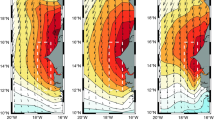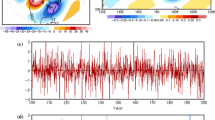Abstract.
Recent studies have suggested that sea surface temperature (SST) is an important source of variability of the North Atlantic Oscillation (NAO). Here, we deal with four basic aspects contributing to this issue: (1) we investigate the characteristic time scales of this oceanic influence; (2) quantify the scale-dependent hindcast potential of the NAO during the twentieth century as derived from SST-driven atmospheric general circulation model (AGCM) ensembles; (3) the relevant oceanic regions are identified, corresponding SST indices are defined and their relationship to the NAO are evaluated by means of cross spectral analysis and (4) our results are compared with long-term coupled control experiments with different ocean models in order to ensure whether the spectral relationship between the SST regions and the NAO is an intrinsic mode of the coupled climate system, involving the deep ocean circulation, rather than an artefact of the unilateral SST forcing. The observed year-to-year NAO fluctuations are barely influenced by the SST. On the decadal time scales the major swings of the observed NAO are well reproduced by various ensembles from the middle of the twentieth century onward, including the negative state in the 1960s and part of the positive trend afterwards. A six-member ECHAM4-T42 ensemble reveals that the SST boundary condition affects 25% of total decadal-mean and interdecadal-trend NAO variability throughout the twentieth century. The most coherent NAO-related SST feature is the well-known North Atlantic tripole. Additional contributions may arise from the southern Pacific and the low-latitude Indian Ocean. The coupled climate model control runs suggest only the North Atlantic SST-NAO relationship as being a true characteristic of the coupled climate system. The coherence and phase spectra of observations and coupled simulations are in excellent agreement, confirming the robustness of this decadal-scale North Atlantic air–sea coupled mode.








Similar content being viewed by others
References
Barnston AG, Livezey RE (1987) Classification, seasonality and persistence of low-frequency atmospheric circulation patterns. Mon Weather Rev 115: 1083–1126
Born K (1996) Tropospheric warming and changes in weather variability over the northern hemisphere during the period 1967–1991. Meteorol Atmos Phys 59: 201–215
Bretherton CS, Battisti DS (2000) An interpretation of the results from atmospheric general circulation models forced by the time history of the observed sea surface temperature distribution. Geophys Res Lett 27: 767–770
Cassou C, Terray L (2001) Oceanic forcing of the wintertime low-frequency atmospheric variability in the North Atlantic European sector: a study with the ARPEGE model. J Clim 14: 4266–4291
Cayan DR (1992) Latent and sensible heat flux anomalies over the northern oceans: the connection to monthly atmospheric circulation. J Clim 5: 354–369
Christoph M, Ulbrich U, Oberhuber JM, Roeckner E (2000) The role of ocean dynamics for low-frequency fluctuations of the NAO in a coupled ocean–atmosphere GCM. J Clim 13: 2536–2549
Davies JR, Rowell DP, Folland CK (1997) North Atlantic and European seasonal predictability using an ensemble of multidecadal atmospheric GCM simulations. Int J Clim 17: 1263–1284
Delworth TL, Knutson TR (2000) Simulation of early 20th century global warming. Science 287: 2246–2250
Enfield DB, Mestas-Nuñes AM (1999) Multiscale variabilities in global sea surface temperatures and their relationship with tropospheric climate patterns. J Clim 12: 2719–2733
Frankignoul C (1985) Sea surface temperature anomalies, planetary waves and air–sea feedback in the middle latitudes. Rev Geophys 23: 357–390
Glowienka-Hense R (1990) The North Atlantic Oscillation in the Atlantic-European SLP. Tellus 42A: 497–507
Griffies SM, Brian K (1997) A predictability study of simulated North Atlantic multidecadal variability. Clim Dyn 13: 459–487
Grötzner A, Latif M, Barnett TP (1998) A decadal climate cycle in the North Atlantic Ocean as simulated by the ECHO coupled GCM. J Clim 11: 831–847
Hasselmann K (1991) Ocean circulation and climate change. Tellus 43AB4: 82–103
Higuchi K, Huang J, Shabbar A (1999) A wavelet characterization of the North Atlantic Oscillation variation and its relationship to the North Atlantic sea surface temperature. Int J Clim 19: 1119–1129
Hoerling MP, Hurrell JW, Xu T (2001) Tropical origins for recent North Atlantic climate change. Science 292: 90–92
Hurrell JW (1995) Decadal trends in the North Atlantic Oscillation: regional temperatures and precipitation. Science 269: 676–679
Jenkins GW, Watts DG (1968) Spectral analyses and its applications. Holden-Day series in time series analysis, San Francisco, USA
Joyce TM, Deser C, Spall MA (2000) The relation between decadal variability of subtropical mode water and the North Atlantic Oscillation. J Clim 13: 2550–2569
Latif M (2001) Tropical Pacific/Atlantic Ocean interactions at multi-decadal time scales. Geophys Res Lett 28: 539–542
Latif M, Arpe K, Roeckner E (2000) Oceanic control of decadal North Atlantic sea level pressure variability in winter. Geophys Res Let 27: 727–730
Lunkeit F, von Detten Y (1997) The linearity of the atmospheric response to North Atlantic sea surface temperature anomalies. J Clim 10: 3003–3014
Malberg H, Frattesi G (1995) Changes of the North Atlantic sea surface temperature related to the atmospheric circulation in the period 1973 to 1992. Meteorol Z 4: 37–42
Mehta VM, Suarez MJ, Manganello JV, Delworth TL (2000) Oceanic influence on the North Atlantic Oscillation and associated Northern Hemisphere climate variations: 1959–1993. Geophys Res Lett 27: 121–124
Nitta T, Yamada S (1989) Recent warming of tropical sea surface temperature and its relationship to the Northern Hemisphere circluation. J Meteorol Soc Japan 67: 375–383
Paeth H, Hense A, Glowienka-Hense R, Voss R, Cubasch U (1999) The North Atlantic Oscillation as an indicator for greenhouse-gas induced regional climate change. Clim Dyn 15: 953–960
Paeth H, Friederichs P, Hense A (2001) Covariability and interaction of North Atlantic sea surface temperature and North Atlantic Oscillation. Meteorol Z 10: 295–306
Paeth H, Hense A, Hagenbrock R (2002) Comments on "Twentieth-century trends of Arctic precipitation from observational data and a climate model simulation". J Clim 15: 800–803
Palmer TN, Anderson DLT (1994) The prospects for seasonal forecasting – a review paper. Q J R Meteorol Soc 120: 755–793
Parker DE, Jackson M (1995) The standard GISST data sets: Versions 1 and 2. Workshop on simulations of the climate of the 20th century using GISST. Bracknell, United Kingdom, Hadley Centre, pp 50–51
Perlwitz J, Graf HF, Voss R (2000) The leading variability mode of the coupled troposphere-stratosphere winter circulation in different climate regimes. J Geophys Res 105: 6915–6926
Robertson AW (2001) Influence of ocean–atmosphere interaction on the Arctic Oscillation in two general circulation models. J Clim 14: 3240–3254
Robertson AW, Mechoso CR, Kim YJ (2000) The influence of Atlantic sea surface temperature anomalies on the North Atlantic Oscillation. J Clim 13: 122–138
Rodwell MJ, Rowell DP, Folland CK (1999) Oceanic forcing of the wintertime North Atlantic Oscillation and European climate. Nature 398: 320–323
Roeckner E, Arpe K, Bengtsson L, Brinkop S, Dümenil L, Esch M, Kirk E, Lunkeit F, Ponater M, Rockel B, Sausen R, Schlese U, Schubert S, Windelband M (1992) Simulation of the present-day climate with the ECHAM model: impact of model physics and resolution. Max-Planck-Inst Meteorol Rep 93, Hamburg, Germany
Roeckner E, Arpe K, Bengtsson L, Christoph M, Claussen M, Dümenil L, Esch M, Giorgetta M, Schlese U, Schulzweida U (1996) The atmospheric general circulation model ECHAM-4: Model description and simulation of present-day climate. Max-Planck-Inst Meteorol Rep 218, Hamburg, Germany
Römer U, Hense A (1995) Statistical analysis of tropical climate anomaly simulations. Clim Dyn 11: 178–192
Seager R, Kushnir Y, Visbeck M, Naik N, Miller J, Krahmann G, Cullen H (2000) Causes of Atlantic Ocean climate variability between 1958 and 1998. J Clim 13: 2845–2862
Shindell DT, Miller RL, Schmidt GA, Pandolfo L (1999) Simulation of recent northern winter climate trends by greenhouse-gas forcing. Nature 399: 452–455
Stein O, Hense A (1994) A reconstructed time series of the number of extreme low pressure events since 1880. Meteorol Z 3: 43–46
Stephenson DB, Doblas-Reyes FJ (2000) Statistical methods for interpreting Monte Carlo ensemble forecasts. Tellus 52A: 300–322
Stott PA, Tett SFB, Jones GS, Allen MR, Mitchell JFB, Jenkins GJ (2000) External control of 20th century temperature by natural and anthropogenic forcings. Science 290: 2133–2137
Sutton RT, Allen MR (1997) Decadal predictability of North Atlantic sea surface temperature and climate. Nature 388: 563–567
Timmermann A, Latif M, Voss R, Grötzner A (1998) North Atlantic interdecadal climate variability: a coupled air–sea mode. J Clim 11: 1906–1931
Trenberth KE, Branstator GW, Karoly D, Kumar A, Lau NC, Ropelewski C (1998) Progress during TOGA in understanding and modeling global teleconnection associated with tropical sea surface temperatures. J Geophys Res 103: 14,291–14,324
Ulbrich U, Christoph M (1999) A shift of the NAO and increasing storm track activity over Europe due to anthropogenic greenhouse gas forcing. Clim Dyn 15: 551–559
Venzke S, Allen MR, Sutton RT, Rowell DP (1999) The atmospheric response over the North Atlantic to decadal changes in sea surface temperature. J Clim 12: 2562–2584
von Storch H, Zwiers FW (1999) Statistical analysis in climate research. Cambridge University Press, Cambridge, UK
Walker GT, Bliss EM (1932) World Weather. Mem R Meteorol Soc 4: 53–84
Webster PJ, Magaña VO, Palmer TN, Shukla J, Tomas RA, Yanai M, Yasunari T (1998) Monsoons: processes, predictability, and the prospects for prediction. J Geophys Res 103: 14,451–14,510
Weng W, Neelin JD (1999) Analytical prototypes for ocean–atmosphere interaction at midlatitude. Part II: mechanisms for coupled gyre modes. J Clim 12: 2757–2774
Acknowledgements.
This work was supported by the German Minister of Research and Education under grant 07/GWK02, the German DEKLIM project and the European Union's PREDICATE programm. We thank Drs. Petra Friederichs, Klaus Arpe, Uwe Schulzweida and Ulrich Römer for providing the various ECHAM/GISST data sets.
Author information
Authors and Affiliations
Corresponding author
Rights and permissions
About this article
Cite this article
Paeth, H., Latif, M. & Hense, A. Global SST influence on twentieth century NAO variability. Climate Dynamics 21, 63–75 (2003). https://doi.org/10.1007/s00382-003-0318-4
Received:
Accepted:
Published:
Issue Date:
DOI: https://doi.org/10.1007/s00382-003-0318-4




